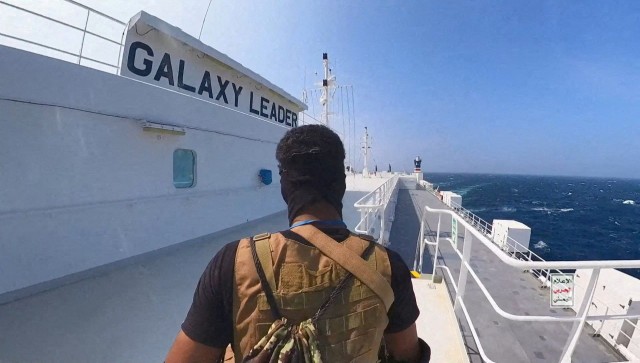The war in West Asia has two fronts now: One is obviously Gaza and the other is the Red Sea which is the busiest route between Asia and Europe. But right now, it’s a danger zone. Yemen’s Houthi rebels are attacking commercial ships. Many companies have started avoiding the route. They are sailing all the way around Africa. So, is India worried about the Houthi threat? How much trade is at stake? And what is New Delhi doing about it? New Delhi is worried about the Red Sea situation. Prime Minister Narendra Modi spoke to Israeli Prime Minister Benjamin Netanyahu on Tuesday. “Had a productive exchange of views on the Israel-Hamas conflict, including shared concerns on the safety of maritime traffic,” said PM Modi after speaking with PM Netanyahu.
India is deploying warships. The Indian Navy already had one warship in the region — The INS Kochi — but now, a second warship — The INS Kolkata — has been sent. Reports say they will operate off the coast of Aden which is located on the southern tip of the Arabian Peninsula. It’s a Yemeni port city. From Aden, one can control Red Sea trade. So that is under India’s focus. On paper, this is not about the Houthis, but about Red Sea pirates. But the timing is key. India’s deployments coincide with the new Red Sea coalition where 10 countries have joined forces. They will defend ships against the Houthis, though India is not part of that coalition, yet, New Delhi is sending warships. In fact, the navy is already part of the action. Last week, a commercial ship was hijacked in the Red Sea. It was a Malta-flagged vessel. The Indian navy immediately sprung to action. It deployed a maritime patrol aircraft. Kept monitoring the crew. Even evacuated one injured soldier. So basically, India was the first responder. However, in this case, the Houthis were not responsible, it was likely Somali pirates who might have seen the chaos caused by the Houthis. So they thought to join in. Now, let’s come to the final question: What is at stake for India? As you know, the Red Sea leads into the Suez Canal which is a key transit point for India. In 2021, India’s trade via the Suez Canal was worth 200 billion dollars, this includes both exports and imports. And around one trillion dollars was India’s total foreign trade. It means around 20 percent of India’s trade is via the Suez Canal. Further, there are two major worries. Number one: Oil, India now has two major suppliers, West Asia and Russia. West Asian oil is shipped via the Persian Gulf. So no problems there. But most of the Russian oil comes via the Suez Canal and the Red Sea, that is 40 percent of India’s total imports (around 1.7 million barrels). If those ships are targeted or re-routed, costs will rise. And number two is the freight costs. So some Indian industry experts are worried. They say shipping costs could rise by up to 40 percent. Meaning, Indian exports will become more expensive. And no country likes to import expensive goods. So India is right to be worried by the Red Sea events. At the same time, India has certain advantages compared to the Western countries. For starters, New Delhi is not involved in the Yemeni civil war. In fact, India and Yemen have long been partners. Around 200 thousand people of Indian origin live in Yemen. Plus, India has close ties with Iran who is the godfather of the Houthis. So New Delhi can pull some strings in Tehran and maybe get the Houthis to ease off their ships. Of course, these are not sustainable options. The best option would be to end the war, and that’s something India has already demanded at the UN General Assembly. Views expressed in the above piece are personal and solely that of the author. They do not necessarily reflect Firstpost’s views.
Read all the Latest News , Trending News , Cricket News , Bollywood News , India News and Entertainment News here. Follow us on Facebook , Twitter and Instagram .
)